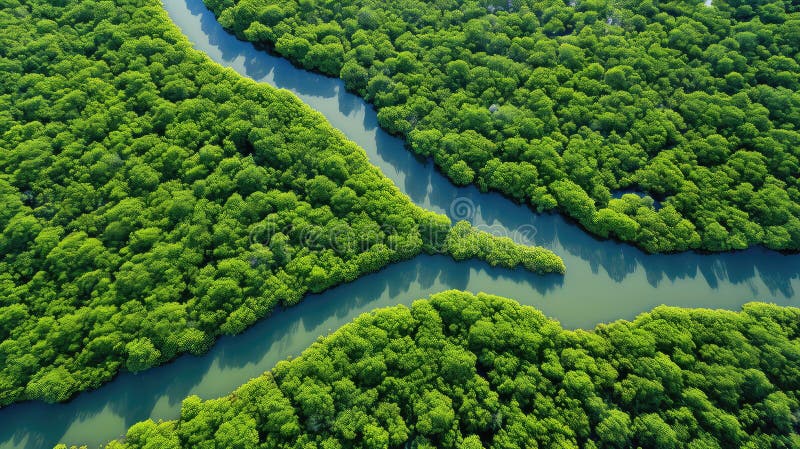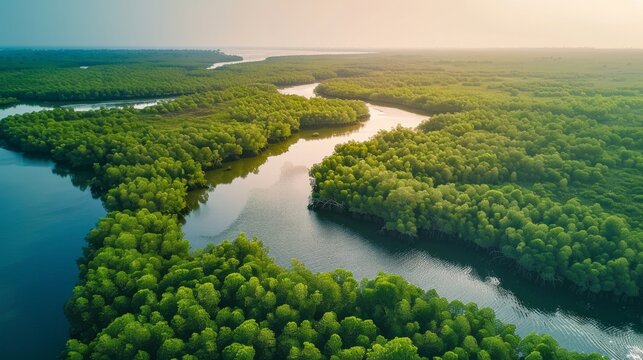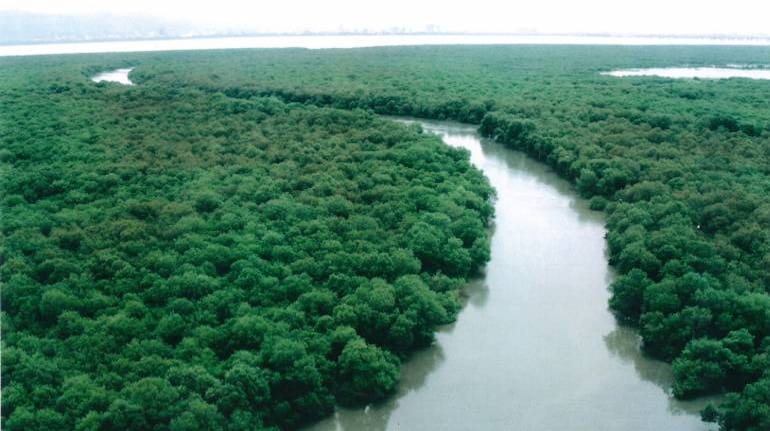Formation of the Sundarbans
Sundarbans formation: The Sundarbans, a UNESCO World Heritage Site, is the world’s largest mangrove forest, stretching across the southern parts of Bangladesh and the eastern region of India. This delta, where the mighty Ganges, Brahmaputra, and Meghna rivers converge, is a fascinating and dynamic landscape shaped by the interplay of land, water, and tidal forces over millennia.

Geological history Sundarbans
The formation of the Sundarbans can be traced back to the Holocene epoch, around 10,000 years ago, following the last Ice Age. As the glaciers melted, massive volumes of water were released, causing sea levels to rise and flood the coastal areas. This inundation led to the creation of the Ganges-Brahmaputra Delta, the foundation upon which the Sundarbans were formed.

The sediment carried by these rivers played a crucial role in the delta’s formation. These sediments, composed of silt, clay, and organic matter, were deposited along the coast, gradually building up the land. Over thousands of years, the continuous deposition of sediments and the action of tidal currents shaped the intricate network of rivers, creeks, and islands that characterize the Sundarbans today.
Mangrove Ecosystem Development
Mangroves are the hallmark of the Sundarbans, providing a unique and vital ecosystem. The development of mangrove forests in this region began around 7,000 years ago. Mangroves are specially adapted to thrive in the harsh conditions of saline and brackish waters, making them ideal for the fluctuating tidal environment of the Sundarbans.

The interplay between freshwater and saltwater, combined with the nutrient-rich sediments, creates an ideal habitat for mangroves. These trees have specialized root systems that allow them to survive in waterlogged conditions and tolerate high salinity levels. Over time, the mangroves established themselves, stabilizing the soil and further contributing to the delta’s expansion.
Sundarbans Evolution
The Sundarbans have witnessed numerous significant events throughout its history, shaping its ecological, cultural, and socio-economic landscape. Here, we explore some of the major events that have left an indelible mark on this unique region.
Colonial Era Exploitation
During the colonial period, the Sundarbans experienced extensive exploitation of its natural resources. The British colonial administration saw the Sundarbans as a vast untapped resource for timber, fuelwood, and other forest products. Large-scale logging operations were conducted, leading to significant deforestation and habitat destruction.

The colonial administration also introduced commercial shrimp farming in the region, further impacting the delicate mangrove ecosystem. The introduction of non-native species and the construction of embankments disrupted the natural hydrological processes, leading to adverse environmental consequences.
Conservation Efforts and Recognition
In the latter half of the 20th century, the ecological importance of the Sundarbans began to be recognized, leading to concerted conservation efforts. In 1973, the Sundarbans was designated a Biosphere Reserve by UNESCO, highlighting its global significance. This designation aimed to promote sustainable development and conservation of the region’s unique biodiversity.
In 1987, the Sundarbans was declared a UNESCO World Heritage Site, further emphasizing its ecological and cultural value. This recognition brought international attention to the need to preserve the Sundarbans and protect its fragile ecosystem from further degradation. You can explore additional details about “Sundarbans formation” in this blog.

Natural Disasters and Climate Change
The Sundarbans are highly vulnerable to natural disasters, particularly cyclones and storm surges. The region has experienced several devastating cyclones, including the 1970 Bhola cyclone, one of the deadliest cyclones in recorded history. These natural disasters have caused significant loss of life, displacement of communities, and extensive damage to the ecosystem. The blog elaborates on “Sundarbans formation” for more details.
Climate change poses an existential threat to the Sundarbans. Rising sea levels, increased frequency and intensity of cyclones, and changes in temperature and precipitation patterns are all impacting the delicate balance of this ecosystem. The erosion of the delta islands and the intrusion of saltwater into freshwater areas are threatening the survival of both the mangrove forests and the communities that depend on them. Details are available in the “Sundarbans formation” part of this blog.

Royal Sundarban Tourism: Promoting Sustainable Exploration
In recent years, tourism has emerged as a significant economic activity in the Sundarbans, offering a unique opportunity to explore this enchanting region while promoting its conservation. Royal Sundarban Tourism is at the forefront of this sustainable tourism movement, providing visitors with an immersive and responsible travel experience. For in-depth information, read “Sundarbans formation” in this blog.
Eco-tourism and Community Engagement
Royal Sundarban Tourism is committed to eco-tourism principles, ensuring that tourism activities have minimal impact on the environment and contribute positively to local communities. The organization works closely with local communities to create awareness about the importance of conservation and sustainable practices.
Read More:
One of the key initiatives of Rayal Sundarban Tourism is involving local communities in tourism activities. This not only provides them with alternative livelihood opportunities but also fosters a sense of ownership and responsibility towards preserving the Sundarbans. Local guides, boatmen, and artisans are integral parts of the tourism experience, offering visitors an authentic and culturally enriching journey. Explore the “Sundarbans formation” section in this blog for more information.

Exploring the Sundarbans with Rayal Sundarban Tourism
Royal Sundarban Tourism offers a range of carefully curated tours that allow visitors to experience the natural beauty and cultural richness of the Sundarbans. From thrilling boat safaris through the dense mangrove forests to serene village walks, each tour is designed to provide a deep connection with the region.
- Boat Safaris: Exploring the labyrinthine waterways of the Sundarbans by boat is an unforgettable experience. These safaris take visitors deep into the heart of the mangrove forest, offering opportunities to spot the elusive Bengal tiger, saltwater crocodiles, spotted deer, and a myriad of bird species. The knowledgeable guides from Rayal Sundarban Tourism enhance the experience with their insights into the flora, fauna, and local folklore.
- Village Walks: To truly understand the Sundarbans, one must connect with its people. Royal Sundarban Tourism organizes village walks that allow visitors to interact with the local communities. These walks provide a glimpse into the traditional way of life, including fishing, honey collection, and handicrafts. Visitors can witness the resilience and resourcefulness of the Sundarbans’ inhabitants, gaining a deeper appreciation for their culture and challenges.
- Bird Watching: The Sundarbans is a birdwatcher’s paradise, with over 260 species of birds recorded in the region. Royal Sundarban Tourism offers specialized bird-watching tours, guided by expert ornithologists. These tours take visitors to prime bird habitats, where they can spot rare and migratory species such as the masked finfoot, mangrove pitta, and the endangered white-bellied sea eagle.
- Cultural Experiences: To immerse visitors in the rich cultural heritage of the Sundarbans, Rayal Sundarban Tourism organizes cultural performances and workshops. Traditional dance and music performances, storytelling sessions, and handicraft workshops provide a unique opportunity to connect with the region’s artistic traditions.
Challenges and Future Prospects
While tourism offers a promising avenue for sustainable development in the Sundarbans, it also presents challenges that need to be carefully managed. Balancing the needs of conservation with the demands of tourism requires a holistic and adaptive approach.
Environmental Impact
The increasing influx of tourists can exert pressure on the delicate ecosystem of the Sundarbans. Pollution, waste management, and disturbance to wildlife are potential risks that need to be addressed. Royal Sundarban Tourism is committed to implementing stringent environmental practices, including waste management protocols, eco-friendly materials, and awareness campaigns to educate visitors about responsible tourism.
Community Participation and Benefit
Ensuring that local communities benefit equitably from tourism is crucial for long-term sustainability. Royal Sundarban Tourism actively involves local stakeholders in decision-making processes and shares the economic benefits of tourism with them. This approach enhances community livelihoods and fosters a sense of stewardship towards the Sundarbans’ conservation.
Climate Change Adaptation
The Sundarbans are on the frontline of climate change impacts. Adapting to these changes is essential for the survival of both the ecosystem and the communities. Royal Sundarban Tourism supports initiatives that promote climate resilience, such as mangrove restoration projects, sustainable fishing practices, and community-based disaster preparedness programs.
Conclusion
The Sundarbans, with their breathtaking landscapes, rich biodiversity, and resilient communities, stand as a testament to the wonders of nature. Its formation, shaped by geological forces and hydrological processes, has created a unique and vital ecosystem that supports countless species and human livelihoods. Also, you can Book the Sundarban Tour At Maity Tourism and Sundarban Leisure Tourism Powered By Argusdna,
We have a genuine registered company Organization: Royal Sundarban Tourism
Organisations Web link: https://royalsundarbantourism.com/
Contact: +91 7439965413 / +91 8584838109
Gpay / Phone pay : 9804049535
Email: info@royalsundarbantourism.com
Address: Village: Tiger More, Gosaba, Pakhiralay, Pakhiralay Main road, District- 24 Parganas South, West Bengal 743370
The major events in the history of the Sundarbans, from colonial exploitation to conservation efforts and the challenges posed by climate change, highlight the delicate balance that needs to be maintained to preserve this natural treasure. Sustainable tourism, championed by organizations like Rayal Sundarban Tourism, offers a pathway to explore and appreciate the Sundarbans while contributing to its conservation and the well-being of its communities.
As visitors embark on their journeys through the Sundarbans with Rayal Sundarban Tourism, they not only witness the beauty and diversity of this remarkable region but also become part of a collective effort to ensure its protection for future generations. Through responsible tourism and community engagement, the Sundarbans can continue to thrive as a sanctuary of nature’s marvels and a source of inspiration for all who venture into its enchanting embrace.

